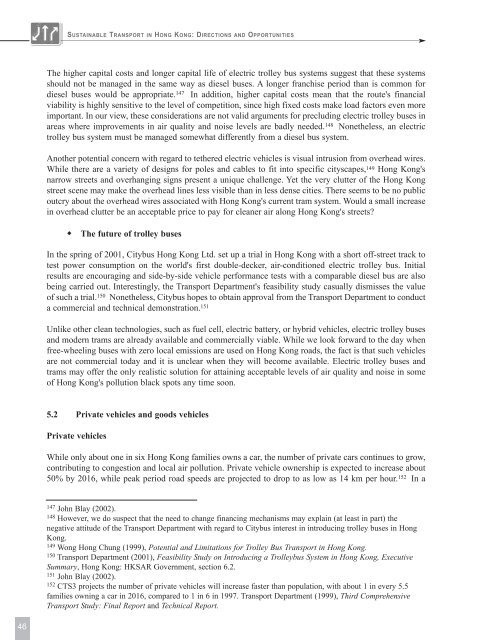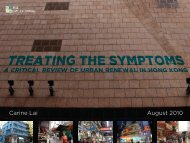Untitled - Civic Exchange
Untitled - Civic Exchange
Untitled - Civic Exchange
You also want an ePaper? Increase the reach of your titles
YUMPU automatically turns print PDFs into web optimized ePapers that Google loves.
SUSTAINABLE TRANSPORT IN HONG KONG: DIRECTIONS AND OPPORTUNITIES<br />
The higher capital costs and longer capital life of electric trolley bus systems suggest that these systems<br />
should not be managed in the same way as diesel buses. A longer franchise period than is common for<br />
diesel buses would be appropriate. 147 In addition, higher capital costs mean that the route's financial<br />
viability is highly sensitive to the level of competition, since high fixed costs make load factors even more<br />
important. In our view, these considerations are not valid arguments for precluding electric trolley buses in<br />
areas where improvements in air quality and noise levels are badly needed. 148 Nonetheless, an electric<br />
trolley bus system must be managed somewhat differently from a diesel bus system.<br />
Another potential concern with regard to tethered electric vehicles is visual intrusion from overhead wires.<br />
While there are a variety of designs for poles and cables to fit into specific cityscapes, 149 Hong Kong's<br />
narrow streets and overhanging signs present a unique challenge. Yet the very clutter of the Hong Kong<br />
street scene may make the overhead lines less visible than in less dense cities. There seems to be no public<br />
outcry about the overhead wires associated with Hong Kong's current tram system. Would a small increase<br />
in overhead clutter be an acceptable price to pay for cleaner air along Hong Kong's streets<br />
• The future of trolley buses<br />
In the spring of 2001, Citybus Hong Kong Ltd. set up a trial in Hong Kong with a short off-street track to<br />
test power consumption on the world's first double-decker, air-conditioned electric trolley bus. Initial<br />
results are encouraging and side-by-side vehicle performance tests with a comparable diesel bus are also<br />
being carried out. Interestingly, the Transport Department's feasibility study casually dismisses the value<br />
of such a trial. 150 Nonetheless, Citybus hopes to obtain approval from the Transport Department to conduct<br />
a commercial and technical demonstration. 151<br />
Unlike other clean technologies, such as fuel cell, electric battery, or hybrid vehicles, electric trolley buses<br />
and modern trams are already available and commercially viable. While we look forward to the day when<br />
free-wheeling buses with zero local emissions are used on Hong Kong roads, the fact is that such vehicles<br />
are not commercial today and it is unclear when they will become available. Electric trolley buses and<br />
trams may offer the only realistic solution for attaining acceptable levels of air quality and noise in some<br />
of Hong Kong's pollution black spots any time soon.<br />
5.2 Private vehicles and goods vehicles<br />
Private vehicles<br />
While only about one in six Hong Kong families owns a car, the number of private cars continues to grow,<br />
contributing to congestion and local air pollution. Private vehicle ownership is expected to increase about<br />
50% by 2016, while peak period road speeds are projected to drop to as low as 14 km per hour. 152 In a<br />
147 John Blay (2002).<br />
148 However, we do suspect that the need to change financing mechanisms may explain (at least in part) the<br />
negative attitude of the Transport Department with regard to Citybus interest in introducing trolley buses in Hong<br />
Kong.<br />
149 Wong Hong Chung (1999), Potential and Limitations for Trolley Bus Transport in Hong Kong.<br />
150 Transport Department (2001), Feasibility Study on Introducing a Trolleybus System in Hong Kong, Executive<br />
Summary, Hong Kong: HKSAR Government, section 6.2.<br />
151 John Blay (2002).<br />
152<br />
CTS3 projects the number of private vehicles will increase faster than population, with about 1 in every 5.5<br />
families owning a car in 2016, compared to 1 in 6 in 1997. Transport Department (1999), Third Comprehensive<br />
Transport Study: Final Report and Technical Report.<br />
46

















